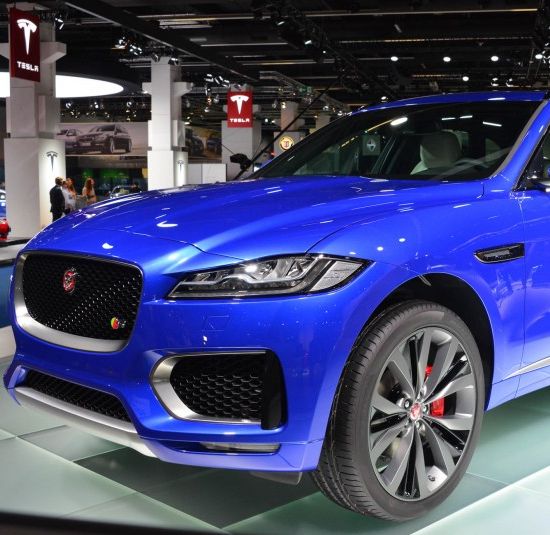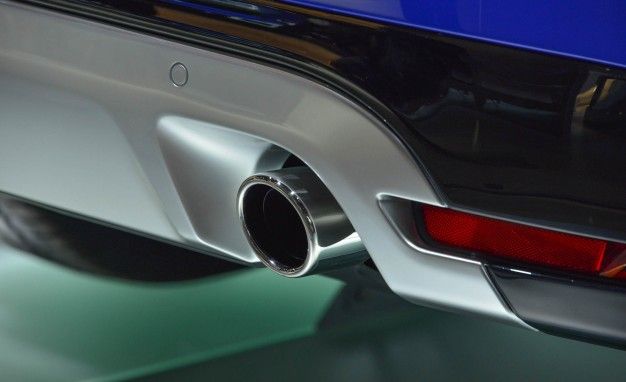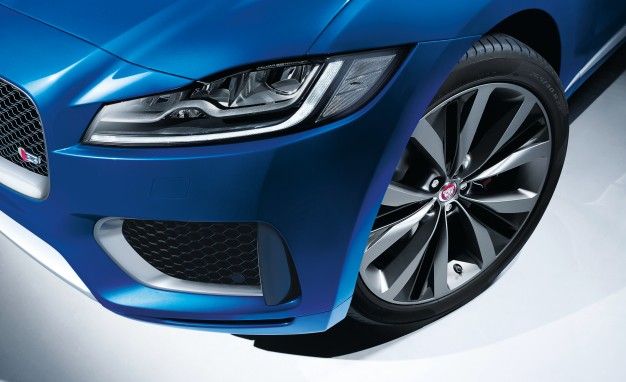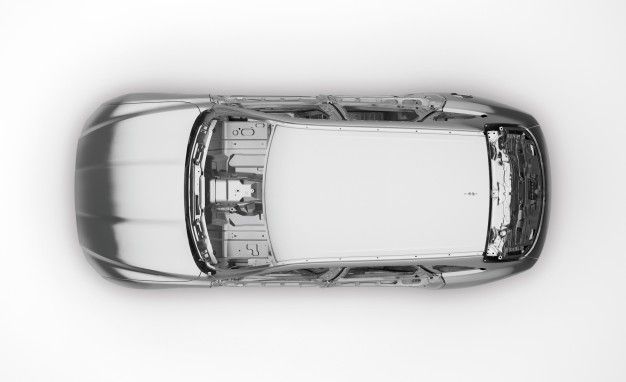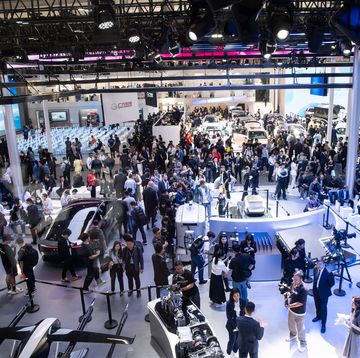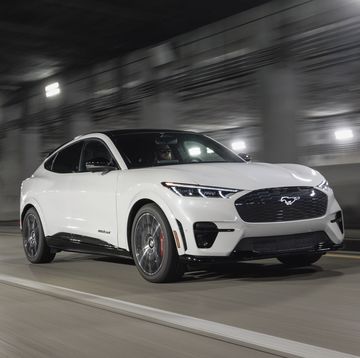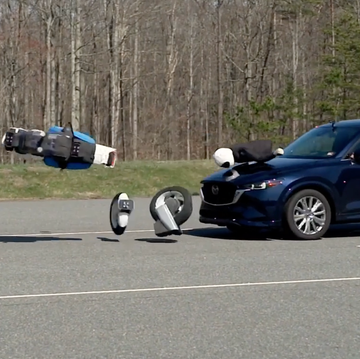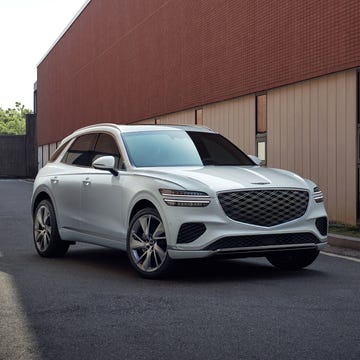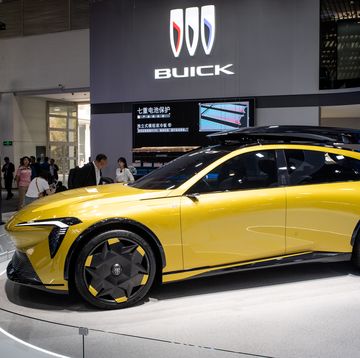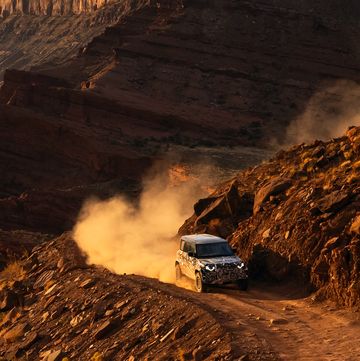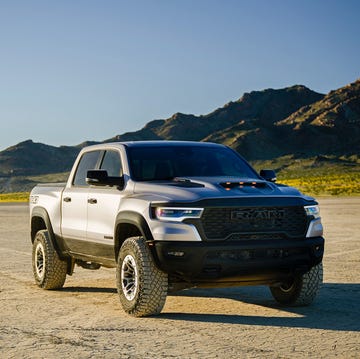The 2017 F-Pace is a big deal—it has to be, if Jaguar is to ever beat its whimsical 15,000 annual sales in the U.S. last year—but the competition has already flexed their summer tires. We spoke with chief designer Ian Callum in Frankfurt, who never thought his pen would stroke such a project, and poked around the F-Pace until pilsners soaked our notepads. Here’s what we learned.
It Almost Got the F-type Exhaust
Jaguar’s 3.0-liter supercharged V-6, which appears throughout the lineup, is smooth, starts pulling early, and ranges in sound from a hushed snarl in the luxurious XJ sedan to the raucous pop-pop-pop of the F-type. The latter car was the F-Pace’s sonic inspiration, says Callum, before the team acquiesced to more family-car expectations. “The first prototypes of this car were a bit louder. We have toned it down a bit,” he said. A raspier note, Callum added, “might have been good for the kids in the back” (and us, too). We haven’t heard an F-Pace run, and there’s no active-exhaust switch—the very first thing we press upon starting an F-type—but we’ll trust it won’t be too tame. Besides, we can appreciate a real exhaust note; Jaguar doesn’t believe in playing fake sounds through the stereo.
There’s a Manual, Rear-Wheel-Drive Diesel
But it’s not coming here. Most European luxury brands offer diesel SUVs, BMW sells a rear-wheel-drive X5, and you can scour the used-car listings for the rare Porsche Cayenne GTS fitted with a stick. Americans just can’t combine all those element into one vehicle. In Europe, Jaguar will offer its 3.0-liter turbo-diesel V-6 delivering 300 horsepower and 516 lb-ft of torque (we’ll get this engine, detuned for emissions, in Td6 models of the 2016 Range Rover and Range Rover Sport). Instead, our F-Pace shares the same base engine as Europe, a 2.0-liter turbo-diesel inline-four with 180 horsepower and 318 lb-ft. It arrives several months after the car’s spring launch.
The Wheels Fill the Wells
While the 265/40R-22 Pirellis—the only choice on the 2000-unit First Edition cars—are positively massive, the F-Pace isn’t much of a weenie on smaller rubber. Base 235/65R-18 tires have no more than five millimeters of additional clearance from the top of the wheel wells than the big rims, Callum’s self-imposed limit on all Jags. It’s so the diameter of the tire doesn’t change the overall look. The same goes for the 19- and 20-inch wheels. Larger sidewalls fill the void, so the vehicle doesn’t look “overbodied,” like an “elephant in a bucket,” Callum said. We’ll bet the 18-inch rubber rides better, too, even if it doesn’t look as hot.
Sits Low Inside, Doesn’t Float
Over at Land Rover, designer Gerry McGovern popularized the trend of finishing all the pillars in gloss black, so that the roof appears to “float” above the car’s body. That’s cool for boxy Range Rovers, but it’s not Jaguar. “You have to include the roofline into the shape of the car,” Callum said. “There’s no way I would consider blacked-out pillars in the front.” The F-Pace also doesn’t feel like a Range Rover, not even the chiseled, low-riding Evoque. The seating position is lower and the center console is higher “so you feel cossetted.”
The HUD Is a Laser Show
Unlike most head-up displays, which focus LCD screens onto the windshield, Jaguar uses lasers—four of them, in different colors—to project what it claims to be a crisper, higher-contrast image. All the usual info is present, such as current speed, speed limit, cruise control, and turn-by-turn directions.
Slices the Air, Only Once
Named “air curtains” by BMW, vertical fender vents to reduce the turbulent drag built up within the wheel wells also appear on the F-Pace. It’s a subtle slit on the farthest corners of the front fascia. But during wind-tunnel testing, Jaguar was satisfied enough without a second slice aft of the wheels, as seen on the X5.
Tap that J
Since the 1980s, you could go for a swim and purposely lock your keys inside a Ford, Mercury, or Lincoln, knowing you wouldn’t have to phone AAA, thanks to a five-digit keypad mounted on the driver’s door. The F-Pace provides that same functionality, via a more suave solution: the Activity Key, a $400 waterproof wristband that looks like a FitBit. It acts as the car’s secondary key fob. Two details make it especially nifty: The main key fob won’t start the engine when it’s locked inside, and the wearer locks and unlocks the car by tapping the “J” on the Jaguar tailgate logo. Jaguar will also roll out an Apple Watch app that will let you lock and start the car in a less athletic (and way geekier) fashion.
First Jaguar Navigation System that Doesn’t Suck
That’s the early indication, anyway, based on the 15-minute demo Jaguar gave at the F-Pace unveiling. Jaguar Land Rover has been screwing up infotainment for years (laggard touch response, maps that get us lost, we could go on), but the latest InControl Touch Pro, designed in-house no less, could be a redeemer. The optional 10.2-inch screen pinches, zooms, and swipes. Input a destination and you’ll get 360-degree Google Street View images and an option to text your location to a friend. The 12.3-inch digital instrument panel can display full-width maps (à la Audi TT), plus it’s customizable in one of four graphical layouts. The onboard 3G internet connection and available processing power allegedly can support four streaming videos at once. This system is also available on the 2016 XF, but we didn’t get a chance to sample it during our first drive. For once, Jaguar electronics may be a selling point.
The Body Is Made from Recycled Aluminum
The F-Pace bolsters its green cred with a body-in-white that is one-third recycled aluminum. That body, which is 80 percent aluminum and 20 percent high-strength steel, weighs 655 pounds. And like the XF sedan, the doors are made from steel to enhance weight distribution. The steel is not recycled from old X-type sedans. Sorry.
You Can’t Fuss with Off-Road Settings
As you probably expected, the F-Pace was built for tarmac. There’s no Terrain Response system here. Instead, when a wheel begins to slip, Jaguar’s Adaptive Surface Control automatically switches among three modes: snow, ice, and wet grass. Essentially, it’s a more limited “auto” setting of Terrain Response, sans any tinkering with diff locks and air suspension. As in the F-type, the F-Pace all-wheel-drive system functions like a rear-driver but can lock a 50-50 torque split within 165 milliseconds.
- 2017 Jaguar F-Pace Crossover: Better Late than Never
- Jaguar Sends F-Pace on Record-Breaking Loop-the-Loop, Because Debut
- 2017 Jaguar F-Pace Full Online Configurator Is Already Live
The F-Pace goes on sale early next year, but you can delve further into it right now. The online configurator is already live, if you want to spec your own.
Clifford Atiyeh is a reporter and photographer for Car and Driver, specializing in business, government, and litigation news. He is president of the New England Motor Press Association and committed to saving both manuals and old Volvos.
